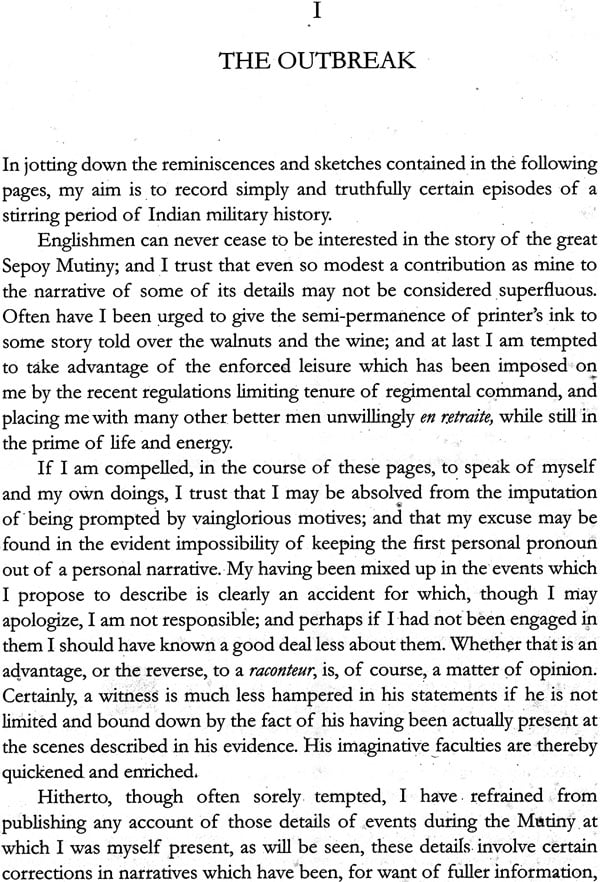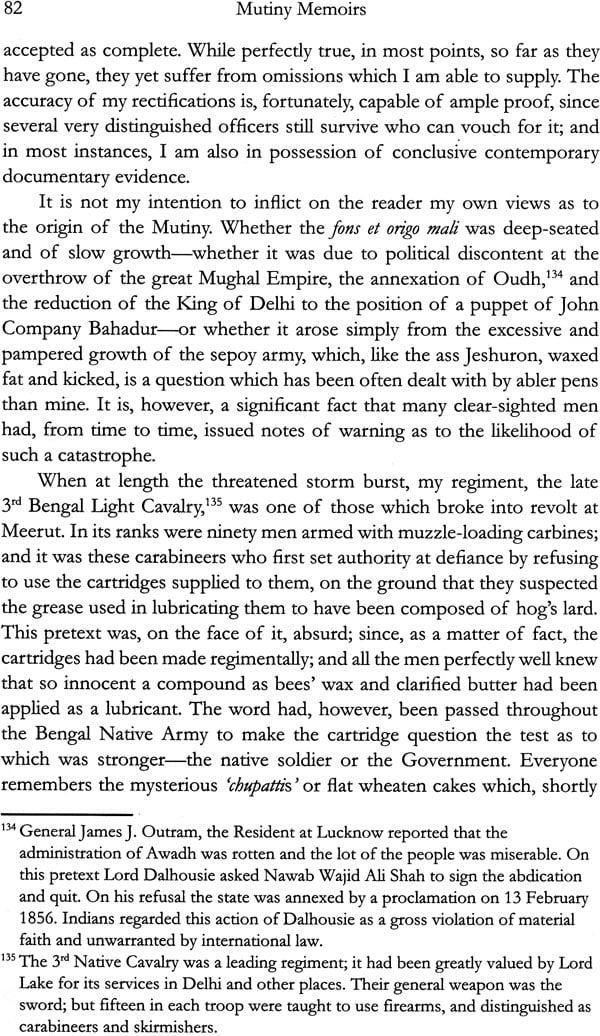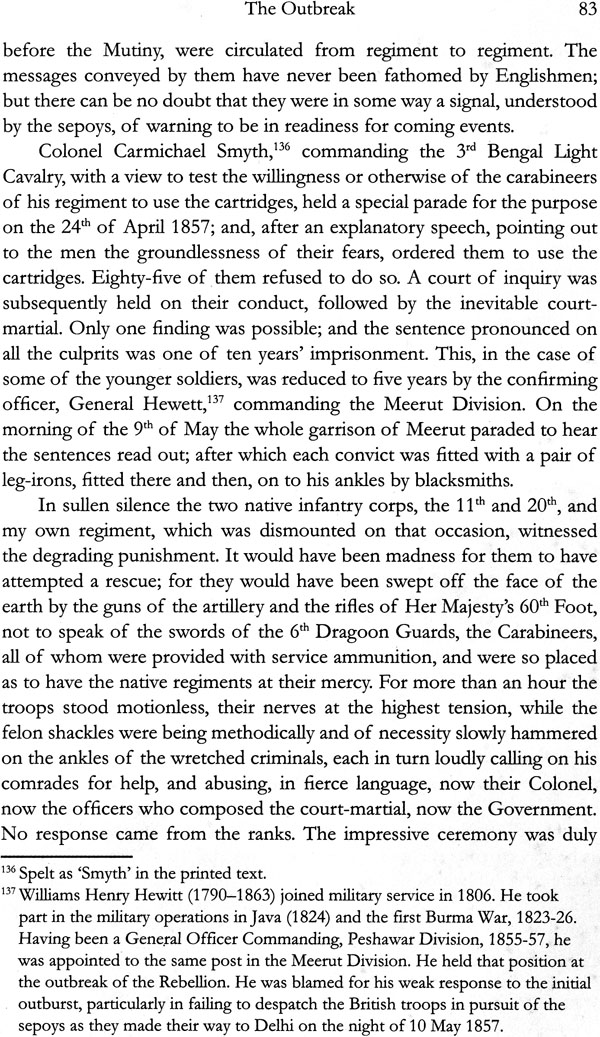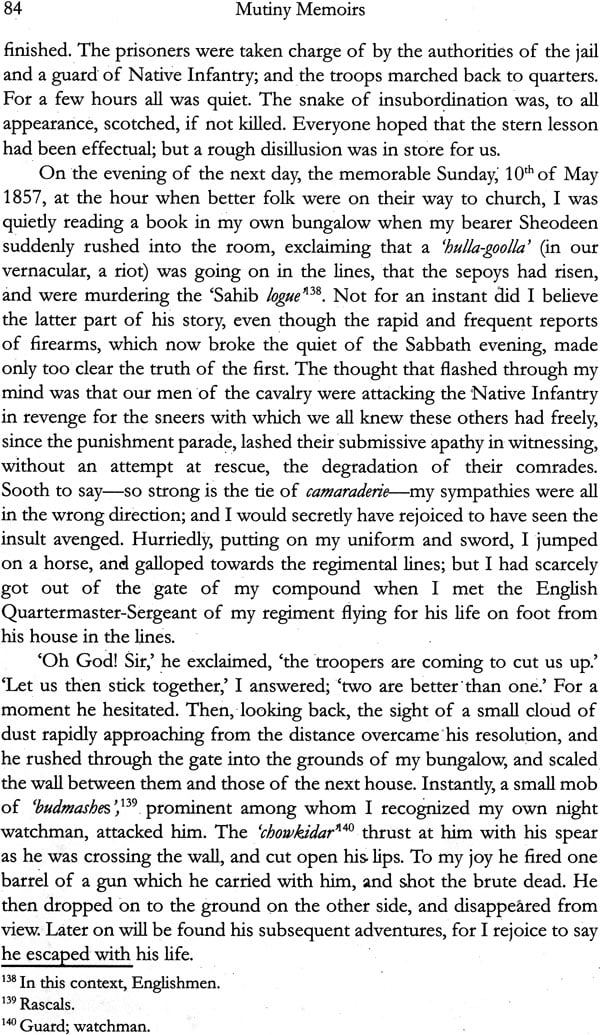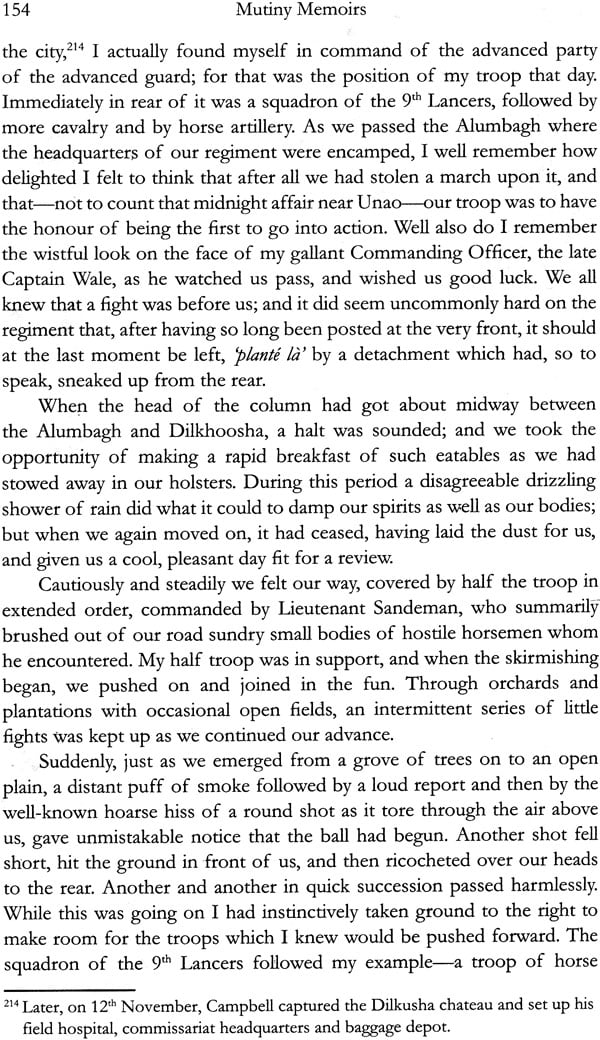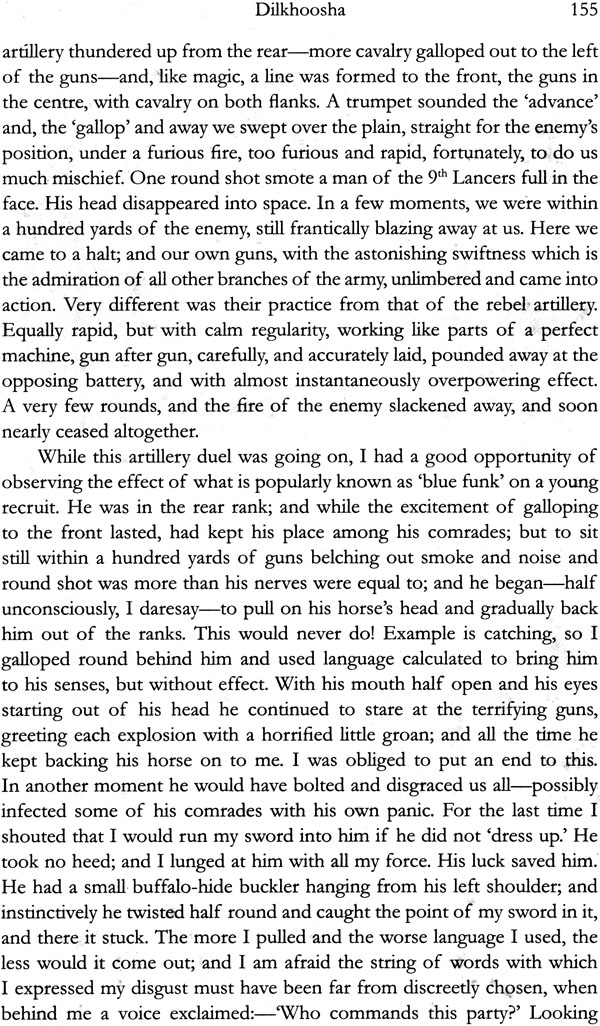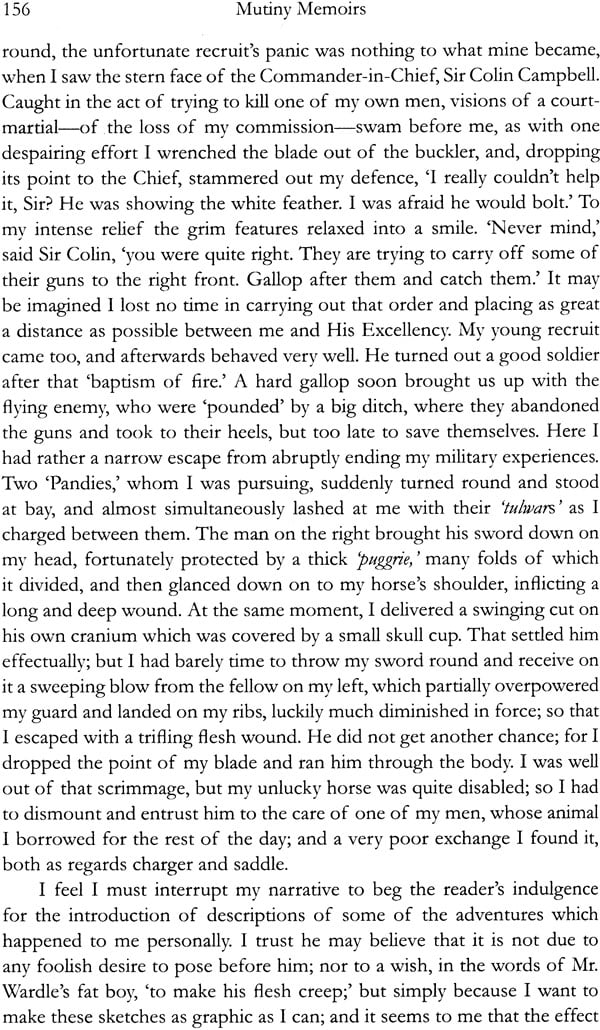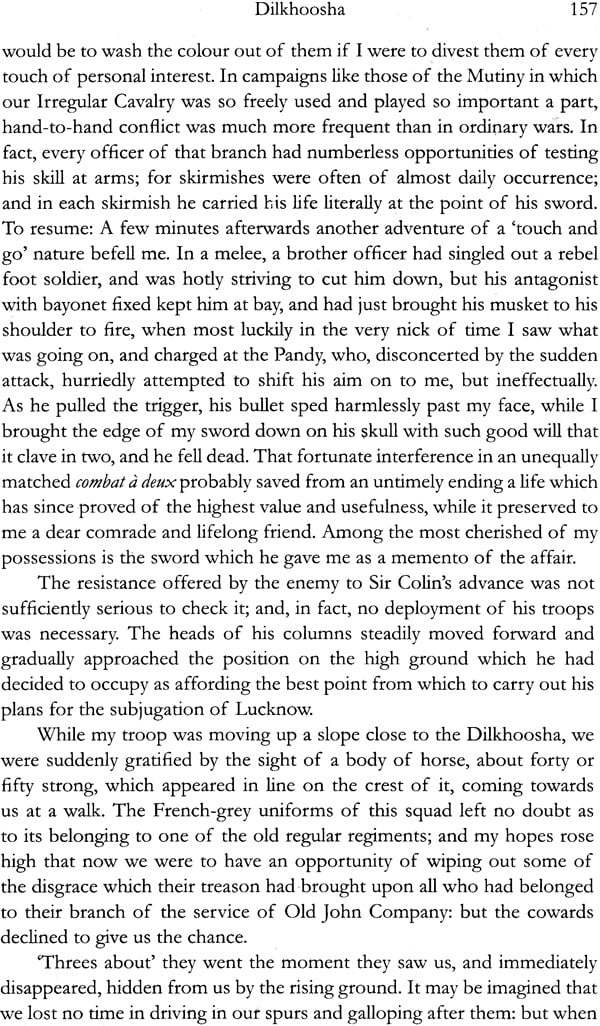
Mutiny Memoirs (Being Personal Reminiscences of The Great Sepoy Revolt Of 1857)
Book Specification
| Item Code: | NAE538 |
| Author: | Mushirul Hasan |
| Publisher: | Niyogi Books |
| Language: | English |
| Edition: | 2008 |
| ISBN: | 9788189738327 |
| Pages: | 172 (14 B/W Illustrations & I Map) |
| Cover: | Paperback |
| Other Details | 9.5 inch X 6.0 inch |
| Weight | 250 gm |
Book Description
The memorable Sunday, 10th of may 1857, at the hour when better folk were on their way to church, I was reading a book in my own bungalow when my bearer Sheodeen suddenly rushed into the room, exclaiming that a bulla-goolla ( in our vernacular, a riot) was going on in the lines, that the sepoys had risen and were murdering the Sahib logue. Note for an instant did I believe the latter part of his story, even though the rapid and frequent reports of firearms, which now broke the quite of the Sabbath evening, made only too dear the truth of the first. The thought that flashed through my mind was that our men of the cavalry were attacking the Native Infantry in revenge for the sneers with which we all knew these others had freely since the punishment parade, lashed their submissive apathy in witnessing without an attempt at rescue, the degradation of their comrades. Sooth to say – so strong is the tie of camaraderie my sympathies were all in the wrong direction and I would secretly have rejoiced to have seen the insult avenged. Hurriedly putting in my uniform and sword, I jumped on a horse and galloped towards the regimental lines: but I had scarcely got out of the gate of my compound when I met the English Quartermaster – Sergeant of my regiment flying for his life on foot from his house in the lines.
Mutiny Memoirs: Being Personal Reminiscences of the Great Sepoy Revolt of 1857 by Colonel A.R.D Mackenzie was originally published in the Pioneer as article.
Born in 1835, Mackenzie entered the Bengal Army in 1854, became Lieutenant Colonel in 1878, and Colonel four later. He belonged to the 3rd Bengal Light Cavalry that also broke into rebellion in Meerut and commanded the 8th Irregular Cavalry at Bareilly when they rebelled. He was also part of the British forces that seized and captured Delhi and Lucknow. Appointed to the regiment of the Bengal Cavalry, he led his regiment as Lieutenant-Colonel during the Second Afghan War, 1879-80. Thereafter he served as honorary ADC to Lansdowne the Viceroy.
‘A men of integrity and liberal views who deplored the severity of the reprisals against the “rebels”, Mackenzie, an eyewitness of the 1857 ‘Revolt’, wrote Mutiny Memoirs based on ‘conclusive contemporary documentary evidence’ of the ‘Revolt’.
Historian Mushirul Hasan analyses the representations of 1857 in Mackenzie text, incorporating in his analyses the insights of Jawaharlal Nehru who contextualized 1857 in the light of latter day anti-colonial movements in Asia and Africa, differentiating Nehru’s frame of analysis from that of other chroniclers – British and Indian – of 1857. The reader is also invited to reflect on how some of Delhi’s prominent citizens coped with the past-1857 decades; the ‘English Peace’; the city’s supposed ‘decline’ and ‘decay’; the so-called Muslim ‘estrangement’ from the British government, and last but not least, the ‘collapse’ of Muslim civilization generally bemoaned – legitimately or otherwise – by several Urdu writers and poets.
Mushirul Hasan, renowned historian and scholar has authored Legacy of a Divided Nation:” India’s Muslims Since Independence (1997); John Company to the Republic: A Story of Modern India (2001); Islam in the subcontinent: Muslims in a Plural Society (2002); From Pluralism to Separatism: Qasbas in Colonial Awadh (2003); A Moral Reckoning; Muslim Intellectuals in Nineteenth-century Delhi (2004); The Nehru’s: Personal Histories (2006); Partners in Freedom: Jamia Millia Islamia (2006) and Wit and Humour in Colonial North India (2007).
He edits the Selected Works of Jawaharlal Nehru a project of the Nehru Memorial Fund, and Towards Freedom (1939), a project for the Indian Council for Historical Research.
In 2007 the Padma Shree was conferred on him.
Thanks to the consistent support and advice of close friends, I have taken rime off from writing my own monographs and edited certain books that have long been forgotten but are still of great value as history source hooks. The response of the readers, who have enjoyed not only the choice of books but also acknowledged the effort that goes into editing a text, including providing an introduction, biographical notes and index, has been very encouraging. Newspapers and journals, too, have found space to reviews such books. Some of these published books are: C.E Andrews, Zakaullab of Delhi; Halide Edib, Inside India; Mohamed Ali, My life: A Fragment: An Autobiographical Sketch of Maulana Mohamed Ali; Westward Bound: Travels of Mirza Abu Taleb; Seamless Boundaries:Lutfullab’s Narrative beyond East and West.
Now, I introduce another absorbingly interesting book—Mutiny ‘Memoirs:: Being Personal Reminiscences of the Great Sepoy Revolt of 1857 (Allahabad, 1891) by Colonel Alfred Robert Davidson Mackenzie. Originally published in the Pioneer as articles, this book has been inaccessible to a number of historians; it is not mentioned in the chapter on ‘The Mutiny’ in The Cambridge History’ of India, edited by H.H. Dodwell Except for S.B. Chaudhuri who mentions Mackenzie’s work is bibliography to Civil Rebellion in the Indian Mutinies (1957), most other well-known writers on 1857—R.C. Majumdar (The Sepoy Mutiny and the Revolt of 1857, Calcutta, 1957); S. Mahdi Husain (Bahadur Shah II and the War of 1857 in Delhi with Unforgettable Scenes, Delhi, 1958); Thomas R.Metcalf(The Aftermath of Revolt India, 1857-1870, New Delhi, 1963); John Pemble (The Raj the Indian Mutiny, and the Kingdom of Oudh, 1801-1859, New Delhi 1977 and Rudrangshu Mukherjee (Awadh in Revolt, 1857-1858: A Study Popular Resistance, New Delhi, 1984)—never made mention of this book. Recentiy, however, it has figured in the bibliography of Wiliiam Dalrymple The Last Mughal: The Fall of a Dynasty, Delhi, 1857 (2006).
Born in 1835, Mackenzie, the author, entered the Bengal Army on 20 December 1854, and received rapid promotions until he became Lieutenant Colonel in 1878, and Colonel four years later. He belonged to the 3rd Bengal Light Cavalry, one that also broke into rebellion in Meerut. He commanded the 8th Irregular Cavalry at Bareilly when they rebelled. Part of the British forces that seized and captured Delhi and Lucknow, he was even slightly wounded during the operations. Appointed to the regiment of Bengal Cavalry, he led his regiment as Lieutenant-Colonel during the Second Afghan War, 1879-80. Thereafter, he served as honorary ADC to Lansdowne, the Viceroy. Mackenzie dedicated his book to Lansdowne.
Mackenzie is referred to as ‘a man of integrity and liberal views who deplored the severity of the reprisals against the ‘rebels’. He is described as ‘a most intelligent and literate man.’ (P.J.O. Taylor, What Real Happened During the Mutiny: A Day-to-Day Account of the Major Events of 185 7-1859 in India, New Delhi, 1997, p. 272). According to Rebecca West, Rudyard Kipling admired Mutiny Memoirs and made a mention of it to Lord Beaverbrook.
An eyewitness, Mackenzie claims to have filled in the gaps and rectified the mistakes in the existing accounts on the 1857 Rebellion. He possessed, so he writes, ‘conclusive contemporary documentary evidence,’ and offers some useful insights.
I found a rare printed copy of Mutiny Memoirs in the Dr. Zakir Husain Library of the Jamia Millia Islamia. The text has been reproduced in full, and in the present edition, carries biographical notes and comments on certain events. Biographical notes on a few officers were unavailable. I have corrected the many spelling mistakes but retained some, especially of place names. In my Introduction, the expression ‘rebellion’ rather than ‘revolt’ has been used; its usage has no specific connotation. The illustrations are drawn from James Grant’s, Cassell’s Illustrated History of India and Charles Ball’s The History of the Indian Mutiny, Vols. I and 2. Mutiny Memoirs, incidentally, carried no illustrations.
Dipa Chaudhuri has, as usual, taken an active interest in the publication of this text. I am grateful to her. Jawaid Alam assisted me with preparing the biographical notes; Mohammad Javed took on the burden of typing. Thanks to them all.
To many of the British, the first impact of the Mutiny had the stark unreality of a nightmare. Lieutenant Alexander Mackenzie, a young 3rd Cavalry officer, was reading peacefully in his bungalow when his bearer rushed in crying that the sepoys had risen. Mackenzie first instinct was partisan; his own troopers must have set about the sepoys to avenge come taunt prompted by the plight of the eighty-five. As he struggled into his uniform, calling for his horse, his secret hope, as a loyal cavalryman, was that the sepoys had got the drubbing thy deserved.
Vaulting into his saddle, Mackenzie galloped hard for the regimental lines. Sudden7y to his astonishment the 3” Cavalry British quartermaster sergeant came fleeing through the dusk. ‘Oh God, Sir,’ he sobbed, ‘the troopers are coming to cut us up.’
Still, as he glimpsed a white-clad horde of cavalry troops bearing down on him, Mackenzie felt no disquiet. What harm could his own men possibly wish him? Halt,’ he shouted, and it seemed his first instincts had been right; the men had reined in their Arabs a few feet away. Without Warning, a forest of blades slashed at him. Parrying, thrusting, his mind in turmoil, Mackenzie could think only: ‘What has happened? Why are they attacking me?
’ What had happened? All later evidence suggests that the troopers’ sole .concern was a desperate attempt to rescue their comrades from the goal As they .‘thundered 200- strong towards the goal gates, the sentries fled without a shot being fired. Officers who arrived too late saw the eighty-five swarming into the night while blacksmiths worked frantically with hammers and chisels to knock their fetters free. This was at 6p.m. At 7p.m. the rift-raff and cutthroats of bazaars arrived to release the 720 civil prisoners housed there. These now mingled with the sepoys, bent on plunder; the freedom fighters of an hour ago am now a mob ready to rend and claw and gouge.
| Part1 | ||
| Preface | 9 | |
| Musbirul Hasan | ||
| Introduction: Imaging the 1857 Rebellion Musbirul Hasan | 11 | |
| Appendix I | 69 | |
| Appendix II | 70 | |
| Part II | ||
| Mutiny Memoirs: Being Personal Reminiscences of the Great Sepoy Revolt of 1857 Colonel A.R.D. Mackenzie, C.B. | 75 | |
| Dedication | 77 | |
| Preface | 79 | |
| I | The Outlook | 81 |
| II | Skirmishing | 93 |
| III | Before Delhi | 107 |
| IV | Storming the City | 117 |
| V | Capture of Jhujjur | 127 |
| VI | En Route for Lucknow | 137 |
| VII | Dilkhoosha | 149 |
| VIII | Lucknow | 159 |
| IX | A Hero's Death | 166 |
